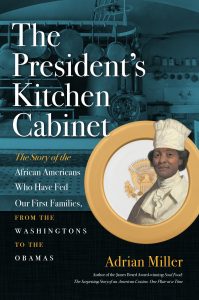By Terri Schlichenmeyer
Eight courses.
You seriously doubted if the food was ever going to stop coming, though you hoped it wouldn’t: you’d tasted all your favorite dishes, and then some. It was a meal fit for a King or Queen. Or maybe a president, and in “The President’s Kitchen Cabinet” by Adrian Miller, you’ll read about First Family feasts.
Last year, while they were on the campaign trail, you might’ve noticed that presidential candidates often enjoyed small-town American cuisine. Their willingness to sample, says Miller, proves that politicians are just like us, a likeness that stops at the White House doors. Presidents, as you know, have staff and many Presidential families have dined on the efforts of African Americans in the White House kitchen.Early accounts of the first Executive Mansion kitchen indicate the enormity of cooking for the President, even then: it was the size of a small house at 43 feet long, 26 feet wide, with fireplaces at either end. Slaves who toiled there lived in the White House basement or attic and were fed the same food the Presidential family received.

George Washington, says Miller, hired white women to cook for him at the beginning of his presidency but later “summoned Hercules,” his Mount Vernon slave, to Philadelphia, making Hercules the first enslaved White House cook.
Thomas Jefferson made sure his enslaved cook, James Hemings, was trained in French cuisine. John Smeades, an accomplished baker who “ran the kitchen” for William Taft, repeatedly ruined the president’s diet with pie; according to long-time White House maid, Lillian Rogers Parks, the Tafts irritated staff by bringing “any number of guests home… without advance warning.”
Eisenhower’s chief usher, Howell Crim struggled once with a request because he didn’t “know what yoghurt was.” When his wife was away, Abraham Lincoln’s staff had to remind the president to eat. Franklin Roosevelt’s cooks were tasked with a special diet for his dog, Fala. William T. Crump, who served as steward in the Garfield White House became the de facto press secretary when the President was shot. And Teddy Roosevelt avoided a sticky situation with help from his steward, Henry Pinckney…
They, of course, weren’t the only African Americans to work in the White House kitchen. Though author Adrian Miller found 150 people by name, he says there were many who toiled unnamed. In “The President’s Kitchen Cabinet,” he explains.
While this may seem like a dry subject, Miller makes it lively through quick, interesting, and sometimes humorous vignettes that dash back and forth through history. It might also have been confusing – official titles changed through the years – but he keeps readers on track with a good variety of tales, just enough relevant backstory, pictures, and (bonus!) recipes you can try.
Surprisingly, this book is quite browse-able and so, whether it’ll sit with your cookbooks or on a shelf with other history tomes, it’s a book you’ll savor in more ways than one. This little bit of history is purely tasty and “The President’s Kitchen Cabinet” is a book you’ll enjoy, of course.





